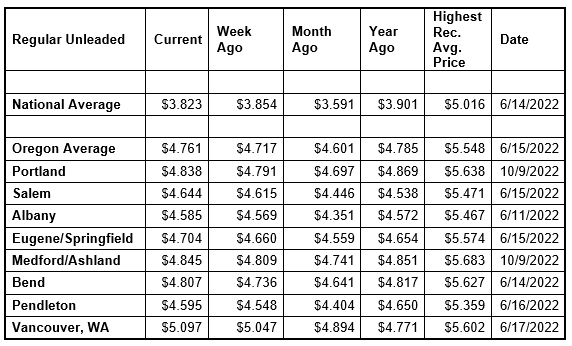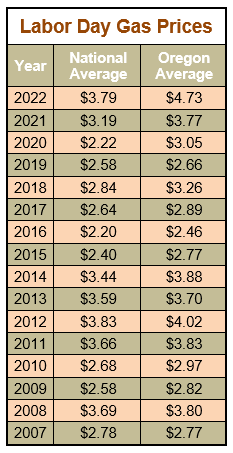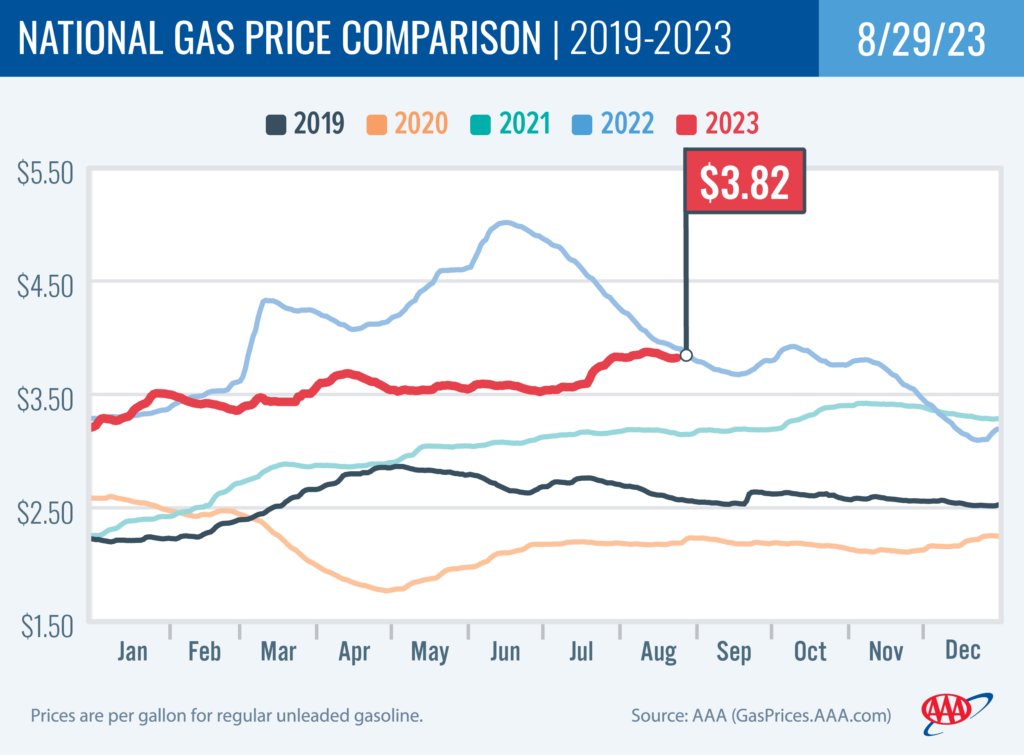But storms could send prices higher
PORTLAND, Ore., – Gas prices are showing minimal movement this week, leading up to the Labor Day holiday. Oregon is one of 48 states where prices have changed by less than a dime. Slightly lower crude oil prices have helped slow increases at the pumps. However, as Labor Day approaches, pump prices could move up again due to increasing demand for gas and an active hurricane season. For the week, the national average dips three cents to $3.82. The Oregon average climbs four cents to $4.76.

Demand for gas is likely to increase leading up to Labor Day. AAA booking data for flights, hotels, rental cars and cruises shows Labor Day travel is up compared to last year. Domestic bookings are up 4% and international bookings are up 44%. Find all the details in the AAA Labor Day travel news release.
“Storms have the potential to disrupt production, especially in the Gulf Coast region where more than 47% of total U.S. petroleum refining capacity is located,” says Marie Dodds, public affairs director for AAA Oregon/Idaho. “Extreme heat can also lead to reduced output at refineries, as we’ve seen this summer.”
Gas prices for the Labor Day holiday weekend will be similar to last year.

Gas prices normally come down in mid-September when the transition to winter-blend fuel begins. It is cheaper to produce than summer-blend fuel, which helps reduce emissions from gasoline during the warm summer months. More info on summer- and winter-blend gasoline can be found at the EPA website.
Crude oil prices have simmered down after rallying for seven weeks in a row. Crude prices dropped below $80 per barrel last week but have nudged past the $80 mark to start this week. The highest price in the last month was about $84 on August 9. The higher crude prices were driven in part by Saudi Arabia’s extension of its production cuts of one million barrels a day through September.
Crude oil is trading around $80 today compared to $80 a week ago and $97 a year ago. In July, West Texas Intermediate ranged between about $69 and $82 per barrel. In June, WTI ranged between about $67 and $73 per barrel. In May, WTI ranged between about $63 and $77 per barrel. In April, WTI ranged between about $73 and $83. In March, WTI ranged between about $64 and $81 per barrel. In February, WTI ranged between about $73 and $80 per barrel. In January, WTI ranged between about $73 and $82 bbl. Crude reached recent highs of $123.70 on March 8, 2022, shortly after the Russian invasion of Ukraine, and $122.11 per barrel on June 8, 2022. The all-time high for WTI crude oil is $147.27 in July 2008.
Crude oil is the main ingredient in gasoline and diesel, so pump prices are impacted by crude prices on the global markets. On average, about 50% of what we pay for in a gallon of gasoline is for the price of crude oil, 25% is refining, 11% distribution and marketing, and 14% are taxes, according to the U.S. Energy Information Administration.
Demand for gasoline rose from 8.85 million b/d to 8.91 million b/d for the week ending August 18, according to the U.S. Energy Information Administration (EIA). This compares to 8.43 million b/d a year ago. Meanwhile, total domestic gasoline stocks increased from 216.2 million bbl to 217.6 million bbl. Although stocks have increased, greater demand over the Labor Day holiday, the impact of weather, and fluctuating oil prices are likely to keep pump prices elevated.
Quick stats
Oregon is one of only eight states with higher prices now than a week ago. Arizona (+10 cents) has the largest weekly jump. Indiana (-13 cents) has the biggest weekly decrease.
California ($5.29) has the most expensive gas in the nation for the fifth week in a row. Washington ($5.10) is second. These are the only two states with averages at or above $5 a gallon. Hawaii ($4.78) is third, Oregon ($4.76) is fourth, Alaska ($4.60) is fifth, Nevada ($4.50) is sixth, Arizona ($4.33) is seventh, Utah ($4.28) is eighth, Idaho ($4.15) is ninth, and Illinois ($4.08) is 10th. These are the 10 states with averages at or above $4 a gallon, down from 11 states and D.C. a week ago. This week 40 states and the District of Columbia have averages in the $3-range. No state has an average in the $2 range this week.
The cheapest gas in the nation is in Mississippi ($3.29) and Louisiana ($3.93). For the 137th week in a row, no state has an average below $2 a gallon.
The difference between the most expensive and least expensive states is almost $2.00 this week, compared to $1.95 a week ago.
Oregon is one of 44 states and the District of Columbia with higher prices now than a month ago. The national average is eight cents more and the Oregon average is 16 cents more than a month ago. This is the eighth-largest monthly increase in the nation. Arizona (+51 cents) has the largest monthly jump. South Carolina (-7 cents) has the smallest.
Oregon is one of 36 states and the District of Columbia with lower prices now than a year ago. The national average is three cents less and the Oregon average is two cents less than a year ago. Hawaii (-53 cents) has the largest yearly drop. Washington (+36 cents) has the largest year-over-year increase.
West Coast
The West Coast region continues to have the most expensive pump prices in the nation with all seven states in the top 10. It’s typical for the West Coast to have six or seven states in the top 10 as this region tends to consistently have fairly tight supplies, consuming about as much gasoline as is produced. In addition, this region is located relatively far from parts of the country where oil drilling, production and refining occurs, so transportation costs are higher. And environmental programs in this region add to the cost of production, storage and distribution.
| Rank | Region | Price on 8/29/23 |
| 1 | California | $5.29 |
| 2 | Washington | $5.10 |
| 3 | Hawaii | $4.78 |
| 4 | Oregon | $4.76 |
| 5 | Alaska | $4.60 |
| 6 | Nevada | $4.50 |
| 7 | Arizona | $4.33 |
| 8 | Utah | $4.28 |
| 9 | Idaho | $4.15 |
| 10 | Illinois | $4.08 |
As mentioned above, California has the most expensive gas in the country. Washington, Hawaii, Oregon, Alaska, Nevada, and Arizona round out the top seven. Oregon is fourth for the 12th week in a row.
All states in the West Coast region except Hawaii are seeing week-over-week increases. Arizona (+10 cents) has the largest jump in the region and the nation. Hawaii (-6/10ths of a cent) is the only state in the region with a week-over-week decline.
The refinery utilization rate on the West Coast fell from 91.6% to 90.3% for the week ending August 18. This rate has ranged between about 73% to 96% in the last year. The latest national refinery utilization rate slipped from 94.7% to 94.5%.
According to EIA’s latest weekly report, total gas stocks in the region decreased slightly from 28.18 million bbl. to 27.95 million bbl.
A lower refinery utilization rate and a decrease in gasoline stocks can put upward pressure on pump prices.
Oil market dynamics
Crude oil prices fell below $80 last week after climbing to $84 per barrel on August 9, the highest price since mid-April 2023. Prices are hovering around $80 to start this week. Concerns linger about China’s economic recovery after the pandemic. Additionally, the EIA reported that total domestic commercial crude inventories decreased from 439.7 million bbl. to 433.5 million bbl.
At the close of Friday’s formal trading session, WTI added 78 cents to settle at $79.83. At the close of Monday’s formal trading session, WTI added 27 cents to settle at $80.10. Today crude is trading around $80 compared to $80 a week ago. Crude prices are about $13 less than a year ago.

Drivers can find current gas prices along their route with the free AAA Mobile app for iPhone, iPad and Android. The app can also be used to map a route, find discounts, book a hotel and access AAA roadside assistance. Learn more at AAA.com/mobile.
Diesel
For the week, the national average rises six cents to $4.41 a gallon. The record high is $5.816 set on June 19, 2022. The Oregon average jumps 14 cents to $4.99. The record high is $6.47 set on July 3, 2022. A year ago the national average for diesel was $5.06 and the Oregon average was $5.64.
Find current fuel prices at GasPrices.AAA.com.
AAA news releases, high resolution images, broadcast-quality video, fact sheets and podcasts are available on the AAA NewsRoom at NewsRoom.AAA.com.
Find local news releases at https://oregon.aaa.com/community/media/media-contacts.html
Fuel prices are updated daily at AAA’s Daily Fuel Gauge at AAA Gas Prices. For more info go www.AAA.com. AAA Oregon/Idaho provides more than 880,000 members with travel, insurance, financial and automotive-related services, and is an affiliate of AAA National, serving more than 63 million motorists in North America.

